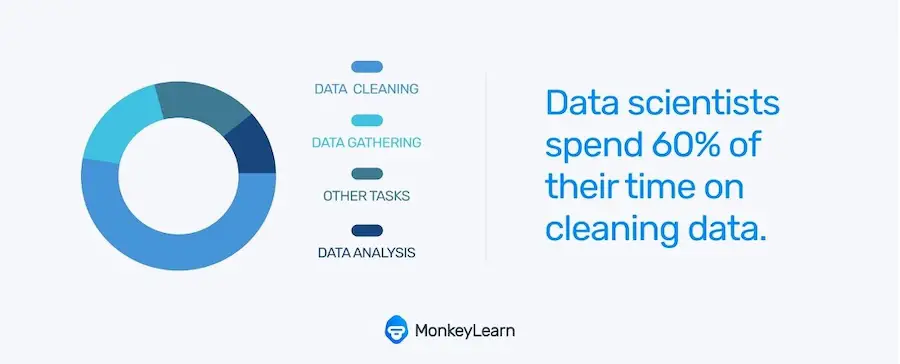Data Cleansing Framework to Avoid Wasting Resources on Dirty Data

Have you ever worried that the data you collect, often considered an asset of your organization, could be corrupted or unexpectedly transform into a significant liability?
According to ZoomInfo, bad data costs U.S. businesses more than $611 billion each year, which is a colossal waste. Data becomes bad and more of a hassle than an asset when organizations neglect regular data management and data cleansing practices.
Inaccurate, outdated, or inconsistent data lead to costly misjudgments and resource wastage. For instance, imagine a marketing campaign that is based on incorrect information about customers, or a supply chain informed by inaccurate inventory data; the outcomes of poor data can be catastrophic for your business goals, budget and bottom line, to say the least.
Cons of Dirty Data – How Dirty Data Drains Resources
Dirty data is akin to a slow and silent drain on an organization's resources. It might not be immediately apparent, but over time its impact can be profound.
Here are a few ways in which dirty data drains resources:
1. Time-consuming manual corrections
Dirty data often needs manual intervention to correct errors, fill in missing values, and remove duplicates. Data analysts and IT professionals spend about 60% of their time on these tasks, which can otherwise be allocated to more strategic activities.

2. Failed data-driven projects
When data isn't clean and reliable, data-driven projects are more likely to fail. Whether it's a predictive analytics initiative or a machine learning model, the results can be entirely useless due to dirty data. It can waste the time and effort employees spend working on these projects.
3. Ineffective marketing campaigns
For businesses, marketing is a critical function. Dirty data can lead to a waste of marketing efforts. In cases where the customer contact information is inaccurate, for example, marketing teams waste resources and time sending messages to the wrong recipients, resulting in low ROI.
4. Customer dissatisfaction and loss of trust
Inaccurate data can lead to customers receiving irrelevant or incorrect communications. This not only frustrates customers, but also erodes their trust in the organization. Rebuilding that trust will require additional resources and effort.
5. Compliance penalties
Failure to comply with regulations of the region, nation, or industry can result in hefty fines and legal battles. Resources that could have been invested in growth or innovation are diverted to legal defense and compliance measures.
6. Operational inefficiencies
Dirty data can disrupt internal processes and workflows. For example, inaccurate inventory data can lead to overstocking or under-stocking, resulting in wasted storage space and financial resources.
Data Cleansing Framework/Strategy to Stop Wasting Resources

Although dirty data can drain resources in many ways, you can create a comprehensive data cleansing framework that eliminates the inefficiencies caused by inaccurate data, and maximize the value of your resources. Here is a data cleansing framework you can use to clean your data:
1. Data assessment
Before you begin the data cleansing process, it's essential to conduct a comprehensive assessment of your data. This involves:
- Data sources: Identify all the sources of your data, whether they are internal systems, external partners, or third-party data providers. Understanding the data's origin is crucial for tracing data quality issues.
- Data relevance: Determine whether the data is relevant to your current business objectives. Over time, organizations may accumulate data that is no longer useful or necessary, so it's important to assess its ongoing relevance.
- Data quality goals: Set clear data quality goals and standards that align with your organization's needs and objectives. These standards will serve as a benchmark for assessing and improving data quality.
2. Data profiling
This includes examining, analyzing, and summarizing your data to gain a deeper understanding of its characteristics. This step helps you identify anomalies, outliers, and potential data quality issues.
Key aspects of data profiling include:
- Data structure: Analyze the structure of your data, including the format of fields, data types, and relationships between different datasets. Understanding the data structure is essential for data cleansing and transformation.
3. Data scrubbing
Data scrubbing involves correcting errors, inconsistencies, and inaccuracies within your data. This step aims to ensure that your data is accurate and reliable.
Key aspects of data scrubbing include:
- Correct error: Identify and fix errors in data, like typos, wrong formatting, and so on. Automated tools can assist in identifying and rectifying these issues.
- Handle missing data: Develop strategies for handling missing data, which can involve appending (filling in missing values).
- Remove duplicate data: Identify and remove duplicate records to ensure that each data point is unique and contributes meaningfully to analysis.
- Standardize data: Standardize data formats, units of measurement, and naming conventions to ensure consistency across datasets.
4. Data validation
Data validation is the process of ensuring that data conforms to predefined rules and standards. This step verifies that data is accurate and reliable for analysis and decision-making.
Key aspects of data validation include:
- Validation rules: Define validation rules and ensure that data adhere to these rules. These rules can include data type validation, range checks, and format validation.
- Error reporting: Establish a mechanism for reporting and handling data validation errors. When data fails validation checks, it should trigger notifications or require manual review and correction.
- Data integrity: Double-check that the connection between different sets of data is correct and accurate.
5. Data enrichment
This involves enhancing your existing datasets with additional information from external sources. This process can add context and depth to your data and make it more valuable and useful.
Key aspects of data enrichment include:
- External data sources: Identify relevant external data sources that can complement your existing data. These sources might be LinkedIn, directories, industry-specific databases, etc.
- Data integration: Use tools for integrating external data seamlessly into your existing datasets. This might involve data matching and merging techniques.
- Data validation: Ensure that the enriched data from external sources is accurate and reliable. Validation checks are essential to prevent the introduction of dirty data during the enrichment process.
- Use case alignment: Enrich data with information that aligns with your specific use cases and objectives. Not all external data is relevant, so prioritize enrichment efforts accordingly.
6. Data governance
Data governance is the framework that provides guidelines, policies, and procedures for managing and maintaining data quality over time. It ensures that data quality remains a priority and is upheld throughout the organization.
Key aspects of data governance include:
- Data ownership: Clearly define data ownership, specifying who is responsible for data quality and integrity within the organization.
- Data policies: Develop and enforce data quality policies, including rules for data collection, storage, validation, and retention.
- Data experts: Appoint data specialists responsible for overseeing data quality, monitoring compliance, and resolving data-related issues.
- Data training: Provide training and awareness programs to educate employees about the importance of data quality and their role in maintaining it.
Businesses can use this framework to cleanse their incoming data. But with already stored data, it gets difficult to clean it at once.
Tip for Cleansing Existing/Stored Data
Cleansing existing data demands substantial effort from experts and is time-consuming, potentially diverting a business’ focus from critical business operations. In such cases, businesses can outsource data cleansing services to a reputed company.
But why would you outsource data cleansing when you can have an in-house team?
Well, in-house data cleansing often demands substantial time, resources, and expertise to implement and maintain. It requires ongoing training for staff, specialized software, and regular updates to meet evolving data quality standards.
Outsourcing data cleansing, on the other hand, not only allows businesses to focus on their core operations, but also grants access to a pool of specialized professionals, cutting-edge technology, and cost-effective solutions. This approach ensures the highest level of data quality without substantial in-house investment.
Conclusion
Remember there isn't a one-size-fits-all approach to data cleansing. The aforementioned steps serve as a roadmap to determine the right procedure and identify issues within your data.
While perfection may be elusive, actively monitoring and understanding the source of errors significantly streamlines future data-cleaning efforts and enhances your data strategy.











![9 Tips for Managing Your Online Writing Projects Efficiently [node:titile]](/sites/default/files/styles/video_thumbnail_bottom/public/open-book-laptop-online-writing-tips.jpeg?itok=rI4zR3a-)







